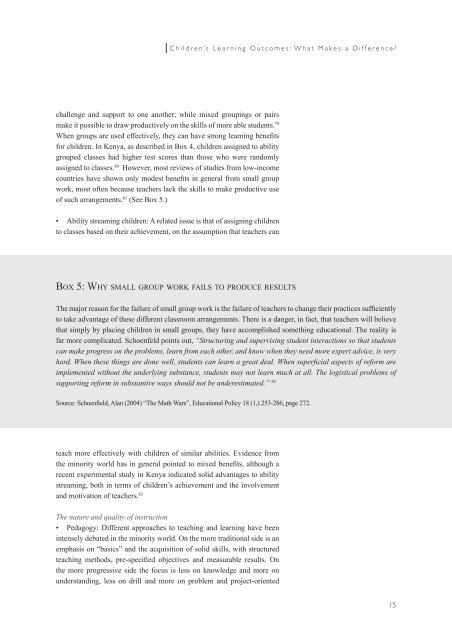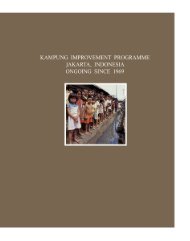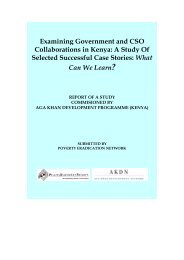Improving Learning Achievement in Early Primary in Low-Income ...
Improving Learning Achievement in Early Primary in Low-Income ...
Improving Learning Achievement in Early Primary in Low-Income ...
You also want an ePaper? Increase the reach of your titles
YUMPU automatically turns print PDFs into web optimized ePapers that Google loves.
Children’s <strong>Learn<strong>in</strong>g</strong> Outcomes: What Makes a Difference<br />
challenge and support to one another; while mixed group<strong>in</strong>gs or pairs<br />
make it possible to draw productively on the skills of more able students. 79<br />
When groups are used effectively, they can have strong learn<strong>in</strong>g benefits<br />
for children. In Kenya, as described <strong>in</strong> Box 4, children assigned to ability<br />
grouped classes had higher test scores than those who were randomly<br />
assigned to classes. 80 However, most reviews of studies from low-<strong>in</strong>come<br />
countries have shown only modest benefits <strong>in</strong> general from small group<br />
work, most often because teachers lack the skills to make productive use<br />
of such arrangements. 81 (See Box 5.)<br />
• Ability stream<strong>in</strong>g children: A related issue is that of assign<strong>in</strong>g children<br />
to classes based on their achievement, on the assumption that teachers can<br />
BOX 5: WHY SMALL GROUP WORK FAILS TO PRODUCE RESULTS<br />
The major reason for the failure of small group work is the failure of teachers to change their practices sufficiently<br />
to take advantage of these different classroom arrangements. There is a danger, <strong>in</strong> fact, that teachers will believe<br />
that simply by plac<strong>in</strong>g children <strong>in</strong> small groups, they have accomplished someth<strong>in</strong>g educational. The reality is<br />
far more complicated. Schoenfeld po<strong>in</strong>ts out, “Structur<strong>in</strong>g and supervis<strong>in</strong>g student <strong>in</strong>teractions so that students<br />
can make progress on the problems, learn from each other, and know when they need more expert advice, is very<br />
hard. When these th<strong>in</strong>gs are done well, students can learn a great deal. When superfi cial aspects of reform are<br />
implemented without the underly<strong>in</strong>g substance, students may not learn much at all. The logistical problems of<br />
support<strong>in</strong>g reform <strong>in</strong> substantive ways should not be underestimated.” 82<br />
Source: Schoenfield, Alan (2004) “The Math Wars”, Educational Policy 18 (1,) 253-286, page 272.<br />
teach more effectively with children of similar abilities. Evidence from<br />
the m<strong>in</strong>ority world has <strong>in</strong> general po<strong>in</strong>ted to mixed benefits, although a<br />
recent experimental study <strong>in</strong> Kenya <strong>in</strong>dicated solid advantages to ability<br />
stream<strong>in</strong>g, both <strong>in</strong> terms of children’s achievement and the <strong>in</strong>volvement<br />
and motivation of teachers. 83<br />
The nature and quality of <strong>in</strong>struction<br />
• Pedagogy: Different approaches to teach<strong>in</strong>g and learn<strong>in</strong>g have been<br />
<strong>in</strong>tensely debated <strong>in</strong> the m<strong>in</strong>ority world. On the more traditional side is an<br />
emphasis on “basics” and the acquisition of solid skills, with structured<br />
teach<strong>in</strong>g methods, pre-specified objectives and measurable results. On<br />
the more progressive side the focus is less on knowledge and more on<br />
understand<strong>in</strong>g, less on drill and more on problem and project-oriented<br />
15

















